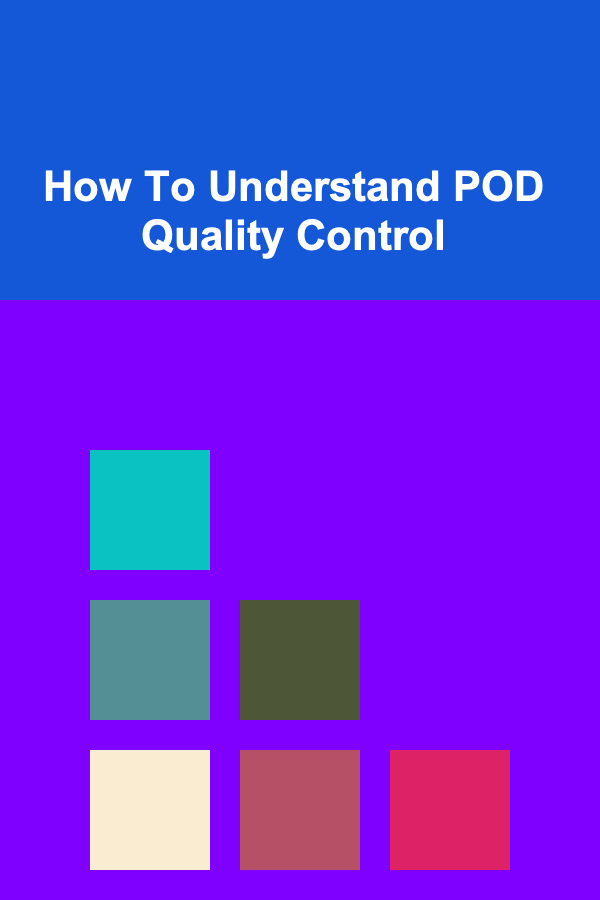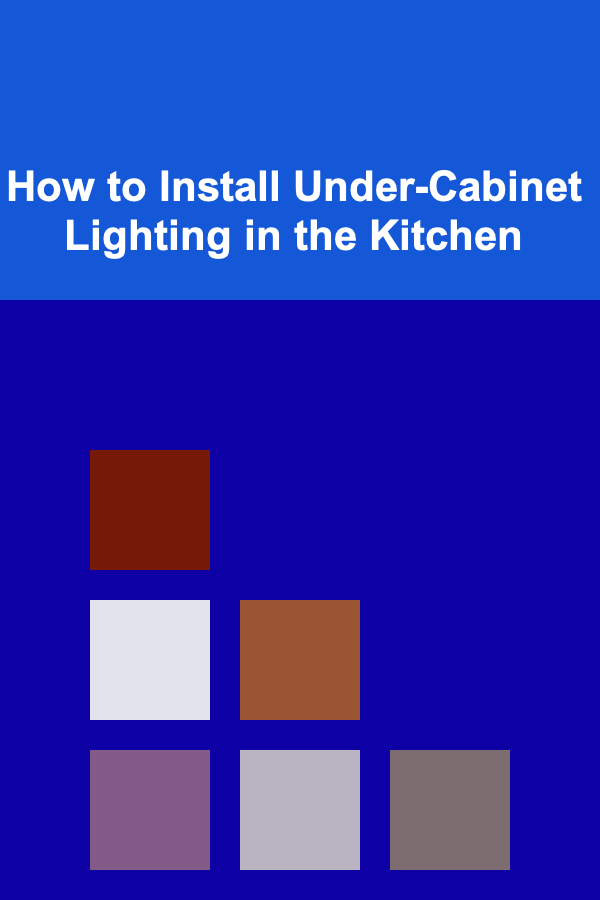
How To Understand POD Quality Control
ebook include PDF & Audio bundle (Micro Guide)
$12.99$8.99
Limited Time Offer! Order within the next:

Print on Demand (POD) has revolutionized the eCommerce industry by allowing entrepreneurs to design and sell custom products without maintaining inventory or managing shipping. With POD, sellers can focus on marketing and product design, while a third-party supplier handles the printing and shipping directly to customers. However, as with any business model, the quality of the products and services delivered is crucial for building customer trust and ensuring long-term success.
In this article, we will explore the concept of POD quality control, its importance, how it works, and the various factors involved. Additionally, we will provide practical steps for maintaining high-quality products in the POD industry.
What is Print on Demand (POD)?
Print on Demand (POD) is a fulfillment model that allows online retailers to sell customized products that are printed only when an order is placed. This model eliminates the need for holding large inventories or managing shipping logistics. POD services typically handle everything, from printing and packaging to delivery.
This model is often used for selling apparel, accessories, home decor, books, and other custom-designed items. Entrepreneurs can upload their designs, choose the products they want to sell, and list them on their eCommerce stores. The POD provider takes care of manufacturing the product and shipping it directly to the customer.
The Role of Quality Control in POD
Quality control in the POD industry is the process of ensuring that products meet the required standards of quality, including design, material, and durability. Since POD involves a third-party supplier handling the production and shipment, it is crucial for the seller to ensure that the end product meets or exceeds customer expectations.
The primary challenge in POD quality control is that the seller does not directly handle or see the product before it reaches the customer. This introduces the risk of defects or mistakes in production, leading to poor customer experiences, negative reviews, and lost sales. To mitigate these risks, sellers need to work closely with their POD suppliers and ensure that proper quality control measures are in place.
Why is POD Quality Control Important?
Quality control in POD is crucial for several reasons:
1. Customer Satisfaction
Customer satisfaction is at the heart of every successful business. When customers receive high-quality products that match the description, they are more likely to leave positive reviews, share their experiences with others, and become repeat buyers. Conversely, subpar quality can lead to dissatisfaction, returns, and negative reviews, damaging your brand reputation.
2. Brand Reputation
In a competitive market, maintaining a strong and positive brand reputation is essential. POD sellers rely heavily on word-of-mouth recommendations and online reviews to attract new customers. A few poor-quality products can significantly damage your brand's reputation, making it harder to win back customers or attract new ones.
3. Minimizing Returns and Refunds
When customers receive defective or low-quality products, they are likely to request returns or refunds. This can result in additional costs for the seller, including the cost of shipping returns, the potential loss of inventory, and the administrative burden of handling customer complaints. By focusing on quality control, you can minimize the risk of returns and refunds, saving both time and money.
4. Reducing Waste
In the POD business, excess inventory is a non-issue since products are only produced when orders are placed. However, low-quality products can lead to unnecessary waste if they are returned or disposed of. Proper quality control can ensure that only the highest-quality items are printed and shipped, helping the business reduce waste and maintain profitability.
5. Compliance with Legal and Safety Standards
POD products must meet certain legal and safety standards depending on the industry and geographical location. For example, apparel sold in the United States must comply with labeling regulations, while products sold in the European Union must meet CE marking standards. POD sellers need to ensure that their products are compliant with the necessary regulations to avoid legal issues and penalties.
Key Elements of POD Quality Control
Effective quality control in the POD industry involves several key elements. Let's break these down in detail:
1. Product Materials and Suppliers
The quality of the materials used in the production of POD items has a direct impact on the overall product quality. As a seller, you need to choose reputable POD suppliers who use high-quality materials that align with your brand values.
- T-Shirts and Apparel: The quality of fabric used for printing custom designs is important for comfort and durability. Look for suppliers that use high-quality cotton, polyester blends, or other premium fabrics. Poor-quality fabrics may shrink, fade, or lose shape after washing.
- Home Decor: Products such as printed pillows, blankets, or wall art should be made from durable, long-lasting materials that can withstand regular use.
- Mugs and Drinkware: The quality of the ceramic, the glaze, and the printing method all affect the longevity and appearance of the products. Mugs should be dishwasher and microwave-safe to meet customer expectations.
- Accessories: Custom-designed accessories, such as phone cases, bags, or hats, should be crafted with attention to detail, ensuring that the material, stitching, and printing are durable and functional.
2. Printing Techniques
The printing technique used to apply your design to the product is crucial for ensuring high-quality results. Different POD providers may use various methods of printing, such as:
- Direct-to-Garment (DTG) Printing: This method is commonly used for apparel and involves printing the design directly onto the fabric. The quality of DTG printing depends on the printer's resolution, the ink used, and the fabric quality.
- Sublimation Printing: This method involves printing the design onto a special paper and then transferring it to the product using heat. Sublimation is often used for products like mugs, phone cases, and home decor. It results in vibrant, long-lasting prints.
- Screen Printing: This is a traditional printing method used for high-volume orders. It involves pushing ink through a screen to create the design on the product. While it produces high-quality prints, it is best suited for simple designs and larger quantities.
- Embroidery: For apparel and accessories like hats or bags, embroidery is a great option for adding a professional, high-quality touch. However, embroidery may not be suitable for intricate or multicolored designs.
As a seller, it is essential to choose the printing technique that suits your product type and design while ensuring that the quality of the print is consistent.
3. Product Design Review
Designs play a critical role in the POD business, and they must be reviewed for both aesthetic and technical quality. A design that looks good on a computer screen might not always translate well to the final product.
- Resolution: Ensure that your designs are of high resolution (300 DPI or higher) to avoid pixelation or blurriness when printed. Low-resolution images can degrade the print quality and lead to unsatisfied customers.
- Color Accuracy: Colors on a screen may look different when printed due to variations in color profiles. Work with your POD supplier to ensure that color accuracy is maintained from the design file to the final product.
- Design Placement: The placement of your design on the product should be consistent and aligned according to the specifications of the POD provider. Poor placement can lead to off-center prints or designs that are cut off.
4. Product Packaging and Shipping
Packaging plays a significant role in the quality control process, as it ensures the product arrives in pristine condition. Products should be packaged securely to prevent damage during transit. POD providers should use protective packaging, such as boxes or padded envelopes, to keep the product safe.
Additionally, the packaging should align with your brand identity. Custom-branded packaging enhances the customer experience and reinforces brand recognition. High-quality packaging can also improve customer perception of your business, creating a more professional and memorable unboxing experience.
Shipping also plays a crucial role in quality control. Timely and accurate delivery ensures that your customers receive their products within the promised time frame, which impacts customer satisfaction.
5. Customer Feedback and Reviews
One of the best ways to monitor product quality is by listening to customer feedback. Customers who receive high-quality products are likely to leave positive reviews, while those who experience issues will provide constructive criticism. Actively monitor reviews on your eCommerce platform and social media channels to identify potential quality issues.
If you receive complaints about product defects or print issues, communicate with your POD supplier to address the problem. A responsive approach to customer feedback shows that you care about your customers and are committed to maintaining high-quality standards.
Best Practices for Managing POD Quality Control
To ensure consistent quality control across all your POD products, here are some best practices you should follow:
1. Select a Reliable POD Supplier
Choose a POD supplier with a strong reputation for delivering high-quality products. Research customer reviews and conduct a trial order to assess the product quality before committing to a long-term partnership. Look for suppliers that offer transparent quality control processes and provide reliable customer support.
2. Request Samples
Before launching your products to customers, order samples from your POD provider to evaluate the quality of materials, printing, and overall product. This allows you to check the final product firsthand and ensure it meets your expectations.
3. Establish Clear Guidelines
Set clear guidelines for your designs, product specifications, and quality expectations. Work closely with your POD provider to ensure that all aspects of the production process, from design file submission to printing and shipping, align with your quality standards.
4. Monitor Consistency
Consistency is key in maintaining quality control. Regularly monitor your products to ensure that the printing, materials, and overall quality remain consistent over time. If you notice any variations, communicate with your supplier to resolve the issue promptly.
5. Offer Quality Assurance to Customers
Provide customers with a satisfaction guarantee or quality assurance policy. If a product arrives damaged or defective, offer a quick and easy returns or replacement process. A fair and transparent policy can help build trust and loyalty among your customers.
Conclusion
Quality control is an essential part of the Print on Demand business. While POD allows for flexibility and low risk, it also requires sellers to ensure that the products they sell meet high standards of quality. From choosing the right materials and suppliers to overseeing the printing process and packaging, quality control plays a central role in customer satisfaction and long-term business success.
By working closely with your POD provider, monitoring the production process, and incorporating customer feedback, you can ensure that your products consistently meet your customers' expectations, leading to a strong and reputable brand. Quality control should not be viewed as an afterthought but as an ongoing process that drives your business toward growth and profitability.

How to Install Under-Cabinet Lighting in the Kitchen
Read More
How to Maximize Your Home's Lighting Potential with the Right Fixtures
Read More
How to Organize Your Closet for a Simpler Cleaning Routine
Read More
How To Learn Aggressive Inline Skating
Read More
How To Identify Chekhov's Gun in Movies
Read More
How To Create a Flexible Work Schedule for FIRE
Read MoreOther Products

How to Install Under-Cabinet Lighting in the Kitchen
Read More
How to Maximize Your Home's Lighting Potential with the Right Fixtures
Read More
How to Organize Your Closet for a Simpler Cleaning Routine
Read More
How To Learn Aggressive Inline Skating
Read More
How To Identify Chekhov's Gun in Movies
Read More